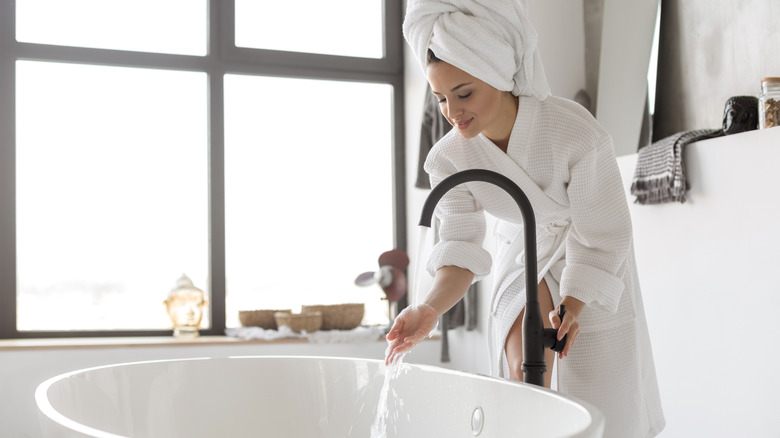Skincare Ingredients To Use If You're Treating Dry, Scaly Skin
We may receive a commission on purchases made from links.
In this ever-changing world of viral skincare, it can be hard to know which products are worth your paycheck and which will lead to things like pilling, an oily complexion, or — worst of all — an allergic reaction. These difficulties are often exacerbated by underlying skin conditions. According to the National Institute of Allergy and Infectious Diseases, approximately 30% of Americans suffer from eczema, and over 80% of people between 12 and 24 deal with acne (via Yale Medicine).
If you have sensitive skin on your face, it can be hard to build a skincare routine. Schedule plenty of time for a patch test before committing to any new ingredients. Esthetician Renée Rouleau recommends doing a trial run on the side of your neck — you may get an itchy spot or two, but at least you won't be dealing with a red rash all over your cheeks and forehead. "The idea is that if it can be tolerated on your neck, then you can feel confident that it will be okay on the face," she tells Byrdie.
Moreover, don't neglect the rest of your body if you have sensitive skin or underlying conditions. You should be cleansing, exfoliating, and moisturizing your arms and legs, too. That being said, because the skin on our legs and arms is often thicker than the skin on our faces, you may need different ingredients to get the job done. Struggling with dryness and scale-like flakes? You're not alone — millions of people suffer from this condition. Here's where to start.
Look for ingredients that exfoliate and moisturize
If your legs are dry, itchy, and beginning to resemble fish scales, it could be you have ichthyosis vulgaris. Fortunately, it's relatively easy to improve topically as long as it's not too severe. According to resident physician and TikTok creator Dr. Jarett Casale (@drjcasale), "[Ichthyosis vulgaris is] caused by a genetic mutation that affects the skin's ability to retain moisture resulting in these fish scale-like regions." The condition often appears in conjunction with eczema and will likely get worse during those dry winter months (definitely not the holiday gift most of us hope for).
Because your body is having trouble cycling skin cells, you're going to have to give a helping hand. In the shower, it can help to use a physical exfoliant like a loofah or a gentle scrub brush. Board-certified dermatologist Dr. Muneeb Shah (@dermdoctor) suggests using ingredients that can simultaneously exfoliate and moisturize your skin. For starters, apply a lactic acid moisturizer up to two times a day, especially after you exit the shower. Dr. Shah recommends AmLactin lotion, which is available for under $15 on Amazon. Alternatively, salicylic acid cream can work wonders — but always check with your dermatologist first to ensure it's not too harsh on sensitive skin. When it comes to ichthyosis vulgaris, the thicker the moisturizer the better. Emollients like urea cream will make sure your legs stay hydrated and decrease the appearance of scale-like patches.
If you weren't a bath person before, now is the time to start
Dealing with dry, scaly skin? Light a few candles, pick out a good book, and turn on the tap. Believe it or not, a bath can be a great treatment for extremely dry skin. "Taking a soak in a lukewarm bath can help because it will improve the moisture content in that top layer of the skin," explains board-certified dermatologist and popular YouTuber Dr. Andrea Suarez (aka Dr. Dray), adding, "By improving the moisture content, you can help facilitate the shedding of those retained corneocytes, allowing the flakes to calm down." Remember that if you suffer from ichthyosis vulgaris you're at a higher risk for skin infection — it's important to take the necessary precautions to prevent long-term effects.
If your scaly skin is particularly severe, submerging yourself in the bath water might lead to some discomfort. To avoid pain, you can apply a layer of Vaseline to particularly dry areas. Alternatively, add a cup of salt to your bathwater — it's kind of like a mini ocean inside your home. Not only can salt help kill some types of bacteria, but Cleveland Clinic says it can also ease the pain of cracking skin. According to Mayo Clinic, mixing about ¼ cup bleach into your bathwater (or as advised by your dermatologist) can also help kill bacteria. However, you'll want to avoid soaking for too long and submerging your head underwater.
Finally, sleeping with a humidifier on can go a long way, especially during dry winter months.


